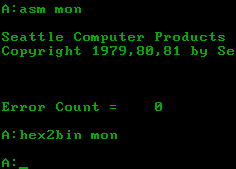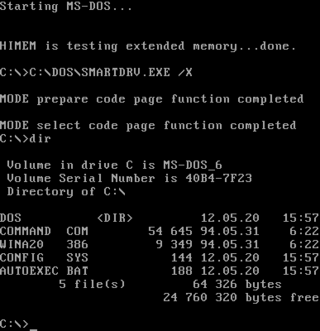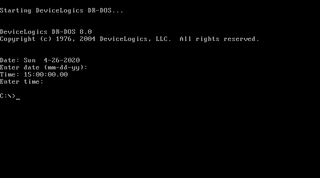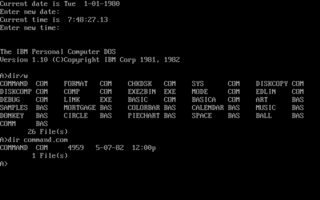 W
W86-DOS is a discontinued operating system developed and marketed by Seattle Computer Products (SCP) for its Intel 8086-based computer kit. Initially known as QDOS, the name was changed to 86-DOS once SCP started licensing the operating system in 1980.
 W
WDOS is a platform-independent acronym for Disk Operating System which later became a common shorthand for disk-based operating systems on IBM PC compatibles. DOS primarily consists of Microsoft's MS-DOS and a rebranded version under the name IBM PC DOS, both of which were introduced in 1981. Later compatible systems from other manufacturers include DR DOS (1988), ROM-DOS (1989), PTS-DOS (1993), and FreeDOS (1998). MS-DOS dominated the IBM PC compatible market between 1981 and 1995.
 W
WDR-DOS is an operating system of the DOS family, written for IBM PC-compatible personal computers. It was originally developed by Gary A. Kildall's Digital Research and derived from Concurrent PC DOS 6.0, which was an advanced successor of CP/M-86. As ownership changed, various later versions were produced with names including Novell DOS and Caldera OpenDOS.
 W
WMS-DOS is an operating system for x86-based personal computers mostly developed by Microsoft. Collectively, MS-DOS, its rebranding as IBM PC DOS, and some operating systems attempting to be compatible with MS-DOS, are sometimes referred to as "DOS". MS-DOS was the main operating system for IBM PC compatible personal computers during the 1980s, from which point it was gradually superseded by operating systems offering a graphical user interface (GUI), in various generations of the graphical Microsoft Windows operating system.
 W
WMultiuser DOS is a real-time multi-user multi-tasking operating system for IBM PC-compatible microcomputers.
 W
WMultiuser DOS is a real-time multi-user multi-tasking operating system for IBM PC-compatible microcomputers.
 W
WMultiuser DOS is a real-time multi-user multi-tasking operating system for IBM PC-compatible microcomputers.
 W
WMultiuser DOS is a real-time multi-user multi-tasking operating system for IBM PC-compatible microcomputers.
 W
WMultiuser DOS is a real-time multi-user multi-tasking operating system for IBM PC-compatible microcomputers.
 W
WMultiuser DOS is a real-time multi-user multi-tasking operating system for IBM PC-compatible microcomputers.
 W
WMultiuser DOS is a real-time multi-user multi-tasking operating system for IBM PC-compatible microcomputers.
 W
WMS-DOS is an operating system for x86-based personal computers mostly developed by Microsoft. Collectively, MS-DOS, its rebranding as IBM PC DOS, and some operating systems attempting to be compatible with MS-DOS, are sometimes referred to as "DOS". MS-DOS was the main operating system for IBM PC compatible personal computers during the 1980s, from which point it was gradually superseded by operating systems offering a graphical user interface (GUI), in various generations of the graphical Microsoft Windows operating system.
 W
WDR-DOS is an operating system of the DOS family, written for IBM PC-compatible personal computers. It was originally developed by Gary A. Kildall's Digital Research and derived from Concurrent PC DOS 6.0, which was an advanced successor of CP/M-86. As ownership changed, various later versions were produced with names including Novell DOS and Caldera OpenDOS.
 W
WThe Atari Portfolio is an IBM PC-compatible palmtop PC, released by Atari Corporation in June 1989. This makes it the world's first palmtop computer.
 W
WMS-DOS is an operating system for x86-based personal computers mostly developed by Microsoft. Collectively, MS-DOS, its rebranding as IBM PC DOS, and some operating systems attempting to be compatible with MS-DOS, are sometimes referred to as "DOS". MS-DOS was the main operating system for IBM PC compatible personal computers during the 1980s, from which point it was gradually superseded by operating systems offering a graphical user interface (GUI), in various generations of the graphical Microsoft Windows operating system.
 W
WDOS Plus was the first operating system developed by Digital Research's OEM Support Group in Newbury, Berkshire, UK, first released in 1985. DOS Plus 1.0 was based on CP/M-86 Plus combined with the PCMODE emulator from Concurrent PC DOS 4.11. While CP/M-86 Plus and Concurrent DOS 4.1 still had been developed in the United States, Concurrent PC DOS 4.11 was an internationalized and bug-fixed version brought forward by Digital Research UK. Later DOS Plus 2.x issues were based on Concurrent PC DOS 5.0 instead. In the broader picture, DOS Plus can be seen as an intermediate step between Concurrent CP/M-86 and DR DOS.
 W
WDR-DOS is an operating system of the DOS family, written for IBM PC-compatible personal computers. It was originally developed by Gary A. Kildall's Digital Research and derived from Concurrent PC DOS 6.0, which was an advanced successor of CP/M-86. As ownership changed, various later versions were produced with names including Novell DOS and Caldera OpenDOS.
 W
WDR-DOS is an operating system of the DOS family, written for IBM PC-compatible personal computers. It was originally developed by Gary A. Kildall's Digital Research and derived from Concurrent PC DOS 6.0, which was an advanced successor of CP/M-86. As ownership changed, various later versions were produced with names including Novell DOS and Caldera OpenDOS.
 W
WDR-DOS is an operating system of the DOS family, written for IBM PC-compatible personal computers. It was originally developed by Gary A. Kildall's Digital Research and derived from Concurrent PC DOS 6.0, which was an advanced successor of CP/M-86. As ownership changed, various later versions were produced with names including Novell DOS and Caldera OpenDOS.
 W
WMS-DOS 4.0 was a multitasking release of MS-DOS developed by Microsoft based on MS-DOS 2.0. Lack of interest from OEMs, particularly IBM, led to it being released only in a scaled-back form. It is sometimes referred to as European MS-DOS 4.0, as it was primarily used there. It should not be confused with PC DOS 4.00 or MS-DOS 4.01 and later, which did not contain the multi-tasking features.
 W
WDR-DOS is an operating system of the DOS family, written for IBM PC-compatible personal computers. It was originally developed by Gary A. Kildall's Digital Research and derived from Concurrent PC DOS 6.0, which was an advanced successor of CP/M-86. As ownership changed, various later versions were produced with names including Novell DOS and Caldera OpenDOS.
 W
WFreeDOS is a free operating system for IBM PC compatible computers. It intends to provide a complete DOS-compatible environment for running legacy software and supporting embedded systems.
 W
WThe Hyperion is an early portable computer that vied with the Compaq Portable to be the first portable IBM PC compatible. It was marketed by Infotech Cie of Ottawa, a subsidiary of Bytec Management Corp., who acquired the designer and manufacturer Dynalogic in January 1983. In 1984 the design was licensed by Commodore International in a move that was forecast as a "radical shift of position" and a signal that Commodore would soon dominate the PC compatible market. Despite computers being "hand-assembled from kits" provided by Bytec and displayed alongside the Commodore 900 at a German trade show as their forthcoming first portable computer, it was never sold by Commodore and some analysts downplayed the pact. The Hyperion was shipped in January 1983 at C$4995, two months ahead of the Compaq Portable.
 W
WIBM PC DOS, an acronym for IBM personal computer disk operating system, is a discontinued operating system for the IBM Personal Computer, manufactured and sold by IBM from the early 1980s into the 2000s.
 W
WMS-DOS is an operating system for x86-based personal computers mostly developed by Microsoft. Collectively, MS-DOS, its rebranding as IBM PC DOS, and some operating systems attempting to be compatible with MS-DOS, are sometimes referred to as "DOS". MS-DOS was the main operating system for IBM PC compatible personal computers during the 1980s, from which point it was gradually superseded by operating systems offering a graphical user interface (GUI), in various generations of the graphical Microsoft Windows operating system.
 W
WMS-DOS 4.0 was a multitasking release of MS-DOS developed by Microsoft based on MS-DOS 2.0. Lack of interest from OEMs, particularly IBM, led to it being released only in a scaled-back form. It is sometimes referred to as European MS-DOS 4.0, as it was primarily used there. It should not be confused with PC DOS 4.00 or MS-DOS 4.01 and later, which did not contain the multi-tasking features.
 W
WThe MS-DOS 5.0 project started in December 1989. MS-DOS 5.0 Codename is "Lifeboat" based on MS-DOS 4.00 Code. MS-DOS 5.00 is first version MS-DOS to use betas builds.
 W
WMS-DOS 4.0 was a multitasking release of MS-DOS developed by Microsoft based on MS-DOS 2.0. Lack of interest from OEMs, particularly IBM, led to it being released only in a scaled-back form. It is sometimes referred to as European MS-DOS 4.0, as it was primarily used there. It should not be confused with PC DOS 4.00 or MS-DOS 4.01 and later, which did not contain the multi-tasking features.
 W
WMultiuser DOS is a real-time multi-user multi-tasking operating system for IBM PC-compatible microcomputers.
 W
WMS-DOS is an operating system for x86-based personal computers mostly developed by Microsoft. Collectively, MS-DOS, its rebranding as IBM PC DOS, and some operating systems attempting to be compatible with MS-DOS, are sometimes referred to as "DOS". MS-DOS was the main operating system for IBM PC compatible personal computers during the 1980s, from which point it was gradually superseded by operating systems offering a graphical user interface (GUI), in various generations of the graphical Microsoft Windows operating system.
 W
WDR-DOS is an operating system of the DOS family, written for IBM PC-compatible personal computers. It was originally developed by Gary A. Kildall's Digital Research and derived from Concurrent PC DOS 6.0, which was an advanced successor of CP/M-86. As ownership changed, various later versions were produced with names including Novell DOS and Caldera OpenDOS.
 W
WDR-DOS is an operating system of the DOS family, written for IBM PC-compatible personal computers. It was originally developed by Gary A. Kildall's Digital Research and derived from Concurrent PC DOS 6.0, which was an advanced successor of CP/M-86. As ownership changed, various later versions were produced with names including Novell DOS and Caldera OpenDOS.
 W
WDR-DOS is an operating system of the DOS family, written for IBM PC-compatible personal computers. It was originally developed by Gary A. Kildall's Digital Research and derived from Concurrent PC DOS 6.0, which was an advanced successor of CP/M-86. As ownership changed, various later versions were produced with names including Novell DOS and Caldera OpenDOS.
 W
WDR-DOS is an operating system of the DOS family, written for IBM PC-compatible personal computers. It was originally developed by Gary A. Kildall's Digital Research and derived from Concurrent PC DOS 6.0, which was an advanced successor of CP/M-86. As ownership changed, various later versions were produced with names including Novell DOS and Caldera OpenDOS.
 W
WIBM PC DOS, an acronym for IBM personal computer disk operating system, is a discontinued operating system for the IBM Personal Computer, manufactured and sold by IBM from the early 1980s into the 2000s.
 W
WFreeDOS is a free operating system for IBM PC compatible computers. It intends to provide a complete DOS-compatible environment for running legacy software and supporting embedded systems.
 W
WDR-DOS is an operating system of the DOS family, written for IBM PC-compatible personal computers. It was originally developed by Gary A. Kildall's Digital Research and derived from Concurrent PC DOS 6.0, which was an advanced successor of CP/M-86. As ownership changed, various later versions were produced with names including Novell DOS and Caldera OpenDOS.
 W
WPTS-DOS is a disk operating system, a DOS clone, developed in Russia by PhysTechSoft and Paragon Technology Systems.
 W
W86-DOS is a discontinued operating system developed and marketed by Seattle Computer Products (SCP) for its Intel 8086-based computer kit. Initially known as QDOS, the name was changed to 86-DOS once SCP started licensing the operating system in 1980.
 W
WDatalight is a privately held software company specializing in power failsafe and high performance software for preserving data integrity in embedded systems. The company was founded in 1983 by Roy Sherrill, and is headquartered in Bothell, Washington. As of 2019 the company is a subsidiary of Tuxera.
 W
WMS-DOS is an operating system for x86-based personal computers mostly developed by Microsoft. Collectively, MS-DOS, its rebranding as IBM PC DOS, and some operating systems attempting to be compatible with MS-DOS, are sometimes referred to as "DOS". MS-DOS was the main operating system for IBM PC compatible personal computers during the 1980s, from which point it was gradually superseded by operating systems offering a graphical user interface (GUI), in various generations of the graphical Microsoft Windows operating system.
 W
WSISNE plus is a DOS 3.3 compatible clone created by Itautec and Scopus Tecnologia in Brazil prior to the end of the Market Reserve in 1991, which, at that time, forbid the importation of electronic equipment and software for general use. With the widespread use of MS-DOS after the importations were allowed, the SISNE plus OS was discontinued.
 W
WMS-DOS is an operating system for x86-based personal computers mostly developed by Microsoft. Collectively, MS-DOS, its rebranding as IBM PC DOS, and some operating systems attempting to be compatible with MS-DOS, are sometimes referred to as "DOS". MS-DOS was the main operating system for IBM PC compatible personal computers during the 1980s, from which point it was gradually superseded by operating systems offering a graphical user interface (GUI), in various generations of the graphical Microsoft Windows operating system.
 W
WFM Towns system is a Japanese variant of PC, built by Fujitsu from February 1989 to the summer of 1997. It started as a proprietary PC variant intended for multimedia applications and PC games, but later became more compatible with IBM PC compatibles. In 1993, the FM Towns Marty was released, a game console compatible with existing FM Towns games.
 W
WWindows 95 is a consumer-oriented operating system developed by Microsoft as part of its Windows 9x family of operating systems. The first operating system in the 9x family, it is the successor to Windows 3.1x, and was released to manufacturing on August 15, 1995, and generally to retail on August 24, 1995. Windows 95 merged Microsoft's formerly separate MS-DOS and Microsoft Windows products, and featured significant improvements over its predecessor, most notably in the graphical user interface (GUI) and in its simplified "plug-and-play" features. There were also major changes made to the core components of the operating system, such as moving from a mainly cooperatively multitasked 16-bit architecture to a 32-bit preemptive multitasking architecture, at least when running only 32-bit protected mode applications.
 W
WWindows 98 is an operating system developed by Microsoft as part of its Windows 9x family of Microsoft Windows operating systems. It is the successor to Windows 95, and was released to manufacturing on May 15, 1998, and generally to retail on June 25, 1998. Like its predecessor, it is a hybrid 16-bit and 32-bit monolithic product with the boot stage based on MS-DOS.
 W
WWindows 98 is an operating system developed by Microsoft as part of its Windows 9x family of Microsoft Windows operating systems. It is the successor to Windows 95, and was released to manufacturing on May 15, 1998, and generally to retail on June 25, 1998. Like its predecessor, it is a hybrid 16-bit and 32-bit monolithic product with the boot stage based on MS-DOS.
 W
WWindows Millennium Edition, or Windows Me, is a graphical operating system developed by Microsoft as part of its Windows 9x family of operating systems. It is the successor to Windows 98 Second Edition (SE), and was released to manufacturing on June 19, 2000, with general availability on September 14, 2000.